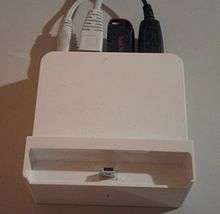Plug computer


A plug computer is an external device, often configured for use in the home or office as a compact computer. It consists of a high-performance, low-power system-on-a-chip processor with several I/O ports (USB ports, ...) and typically runs any of a number of Linux distributions. Most versions do not have provisions for connecting a display and are best suited as for running media server, back-up services, file sharing and remote access functions, thus acting as a bridge between in-home protocols such as Digital Living Network Alliance (DLNA) and Server Message Block (SMB) and cloud based services. There are, however, plug computer offerings that have analog VGA monitor and/or HDMI connectors, which, along with multiple USB ports, permit the use of a display, keyboard, and mouse, thus making them full-fledged, low-power alternatives to desktop and notebook computers.
The name "plug computer" is derived from the small configuration of such devices: plug computers are often enclosed in an AC power plug or AC adapter.
Plug computers typically consume little power and are inexpensive. One manufacturer claims its $119 plug computer draws 1.2 watts and can cost $2 a year to run.[1]
History
A number of other devices of this type began to appear at the 2009 Consumer Electronics Show.
- On January 6, 2009 CTERA Networks launched a device called CloudPlug that provides online backup at local disk speeds and overlays a file sharing service.[2] The device also transforms any external USB hard drive into a network-attached storage device.[3][4]
- On January 7, 2009, Cloud Engines unveiled Pogoplug network access server.[5][6][7][8]
- On January 8, 2009, Axentra announced availability of their HipServ platform.[9]
- On February 23, 2009, Marvell Technology Group announced its plans to build a mini-industry around plug computers.[10][11]
- On August 19, 2009, CodeLathe announced availability of their TonidoPlug network access server.[12]
- On November 13, 2009 QuadAxis launched its plug computing device product line and development platform, featuring the QuadPlug and QuadPC and running QuadMix, a modified Linux.[13]
- On January 5, 2010, Iomega announced their iConnect network access server.[14]
- On January 7, 2010 Pbxnsip launched its plug computing device the sipJack running pbxnsip: an IP Communications platform.[15]
See also
- Classes of computers
- Computer appliance
- CuBox
- GuruPlug
- DreamPlug
- FreedomBox, always-on home server software designed to keep communication private in the face of government surveillance
- Personal web server
- Print server
- SheevaPlug
References
- ↑ "Tonidoplug 2 technical specifications". Archived from the original on April 6, 2012. Retrieved April 6, 2012.
- ↑ "CTERA Networks Launches, Introduces Cloud Attached Storage" (Press release). Ctera networks. 6 January 2009. Retrieved 2009-02-25.
- ↑ Nelson, Fritz (January 11, 2009). CTERA at CES: USB as NAS and Cloud Backup. TechWebTV. Retrieved 2009-01-27.
- ↑ Lawson, Stephen (January 6, 2009). "Startup Ctera will offer cloud storage through carriers". Network World. Retrieved 2009-02-25.
- ↑ Clark, Don; Christopher Lawton (January 8, 2009). "Gadgets for Leaner Times". The Wall Street Journal. Retrieved 2009-01-27.
- ↑ Needleman, Rafe (January 7, 2009). "Pogoplug puts any hard drive on the Internet". The New York Times. Retrieved 2009-02-25.
- ↑ Lester, Dave (January 12, 2009). "Consumer electronics: Take a peek at geek chic". The Denver Post. Retrieved 2009-02-25.
- ↑ Pogoplug brings easy file sharing to your home network. Fast Company. January 7, 2009. Retrieved 2009-02-25.
- ↑ "Axentra Announces HipServ 2.0 for PlugTop Computing" (PDF) (Press release). Axentra. January 8, 2009. Retrieved 2009-02-25.
- ↑ Clark, Don (February 23, 2009). "Marvell Bets on Plug Computers". The Wall Street Journal. Retrieved 2009-02-25.
- ↑ "Marvell Introduces Plug Computing ─ High-Performance, Low-Power, Exceptionally Small Computer for Managing and Storing Digital Media Assets" (Press release). Marvell Technology Group. February 24, 2009. Retrieved 2009-03-16.
- ↑ "CodeLathe introduces TonidoPlug". CodeLathe. 12 August 2009.
- ↑ "QuadAxis Launches Plug Computers". QuadAxis. 13 November 2009.
- ↑ "Iomega's New iConnect Wireless Data Station: Share Files, Manage Torrents, Access Your Data Remotely, Backup Your PC and Mac And Much More for Only $99". Iomega. 5 January 2010.
- ↑ "pbxnsip Demonstrate Sheeva Plug compatibility". pbxnsip. January 7, 2010.
External links
![]() Media related to Plug computers at Wikimedia Commons
Media related to Plug computers at Wikimedia Commons
